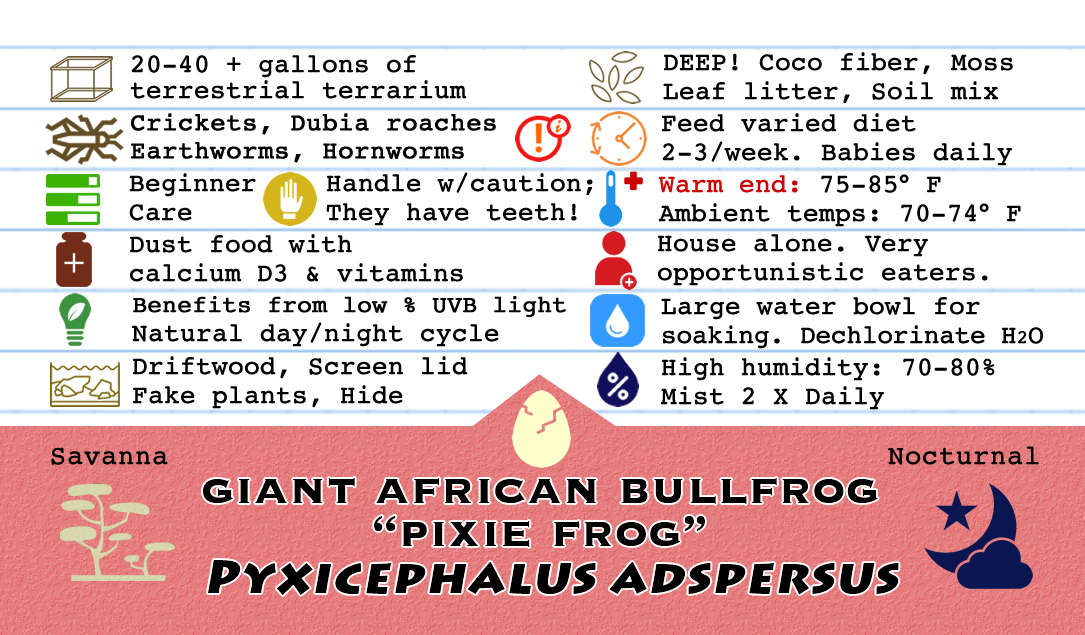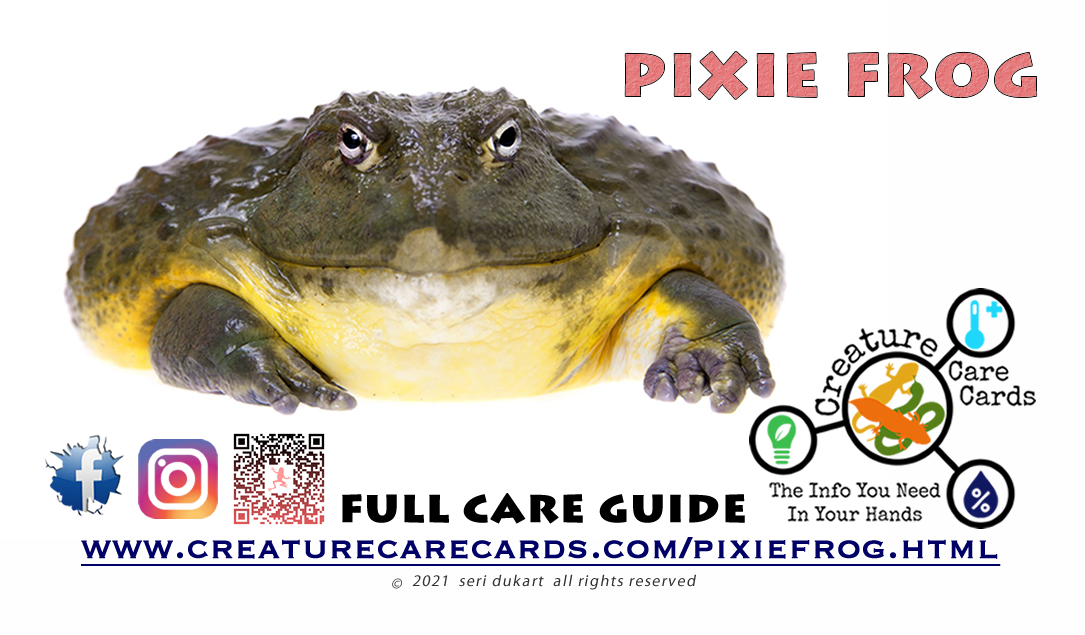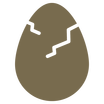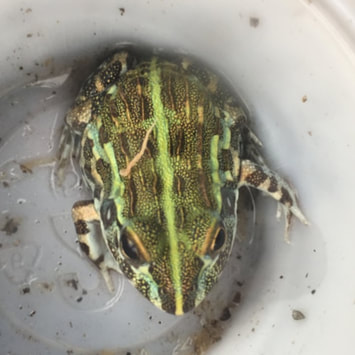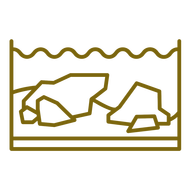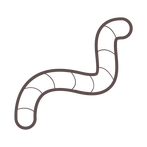Pyxicephalus asperses - Giant African Bullfrog "Pixie Frog"
Giant African Bullfrogs, sometimes called Pixie or Pyxie frogs, are anything but tiny as adults. This rather large frog is native to the savannas, shrublands and water bodies of southern Africa. They are voracious eaters and will happily eat anything that moves, including their owners fingers! They DO have teeth, and their bite can be damaging. They have a long lifespan, and are one of the few species where males are larger than females.
|
Bringing Home Your New Pet
When you bring your new frog home, you should already have a quarantine tank set up and ready to go. Place fresh water in a bowl in the tank, mist the tank and offer food, but be aware it is completely normal for them to refuse food for the first couple days, or even longer. You should keep this new frog separate from any other reptiles you may have for 90 days, to ensure there is nothing it could spread to your other animals. Monitor its eating and fecals as they may be strange for up to a couple weeks, but this is due to a new diet, supplements, and environment. It is recommended you do not handle your new frog for the first 24-48 hours and keeping it to a minimum until it has started eating on its own. Always keep in mind, your new animal is in a new tank, with new decor/dishes/hides, and new faces watching them. They need time to become acclimated to it all. After this quarantine process, they can be safely introduced to their permanent enclosure if it's not already. Be sure to wash your hands before handling any other reptiles during this time. |
|
Enclosure Pixie frogs prefer a lot of space. While they do spend a lot of their time burrowed, when they are active as adults, they need the space to move. Adult females are significantly smaller than males and don't require as much space, but will use it if provided. Minimum for an adult female is 20 gallon long aquarium and for a male, a 40 gallon breeder. More space is always appreciated, and a 75 gallon tank would not be out of the question for this large frog. Babies can be housed in smaller enclosures, but plan to upgrade as they grow, especially once you know your frogs' gender. |
|
Substrate
Pixie frogs spend most of their time buried in the substrate, so a nice, deep loose substrate is important. Eco earth, jungle mix or other soil mixtures are best, with sections of sphagnum moss for added humidity. Make sure the substrate is deep enough for your frog to burrow and hide, and is kept moist. 4-6" is the minimum depth needed for security. They will often burrow until only their eyes can be seen. Do not use pebbles or gravel as the risk of impaction is high. A layer of leaf litter on top will add security for your frog. Spot clean often. |
|
Heating
Pixie frogs are cold blooded, so they rely on their environment to regulate body temperature. A temperature gradient is important for these frogs. The warm side should be in the upper 80's with the cool side being slightly higher than room temperature. Be sure the tank is big enough to allow them to move where they are most comfortable, and the substrate is deep enough to allow burrowing so they can pick the spot that is most comfortable to them. A night time drop to the low 70's is fine. An under tank heater on a thermostat on one side of the tank with temperatures on the hot end being around 75-85° and the rest of the tank staying around 70-74° is ideal. In cooler months or if the room your frog is housed in stays on the cooler range, this additional heat is recommended. Always use a thermostat - if the mat gets too hot, your frog will be injured. Basking spots dry out the air too quickly for this humidity-loving frog, so if you do use a low watt basking bulb for additional heat instead of an under tank heater, be sure to keep an eye on the humidity and mist more often. |
|
Lighting
Pixie frogs are nocturnal, meaning they are most active at night, when they are active at all! However, they should be exposed to 10-12 hours of light per day, be it sunlight, LED or some other light source. Timers are great for keeping a natural lighting schedule. Low output UVB lighting can be offered and is beneficial. Be sure the UVB is 10-12" away from the animal and have lights on a timer to offer a natural day and night light cycle. |
|
Cage Decor
Decorating a pixie frog enclosure can be as simple as substrate, a hide and a water bowl. They are a very sturdy frog, and will likely crush any plants added to the enclosure. Offering plants, pieces of cork bark and other lightweight hides for them to burrow under is optional but will make your tank look nice and offer your frog some visual enrichment. |
|
Humidity and Shedding
Pixie frogs require a high humidity level of around 70-80%. It is not necessary to keep humidity levels high around the clock, but aim for high humidity with natural fluctuations between misting. Ambient humidity levels of 60% with periods of up to 80% are best. Keeping the substrate moist and misting the enclosure daily will keep the humidity level comfortable for your frog. Hand misting is fine, but if you are not home often to mist, an automatic mister is a great investment. Allowing the enclosure to dry out too much may cause your frog to go into a state of dormancy where they grow additional skin layers to act as a cocoon to retain moisture. This process is called estivation. You can avoid this by carefully monitoring their humidity. A hygrometer to measure humidity is a great investment for this species. Pixie frogs will shed their skin and ingest it, so if you notice your frog is particularly slimy looking, they are likely about to shed! |
|
Water
Your pixie frog should have access to a bowl of water to soak in that is deep enough to cover most of their body but not so deep they can't easily get in and out of the bowl. Change this water DAILY as they will drag dirt into their pools and often use them as a latrine. It is recommended to treat water with water conditioner, as frogs are very sensitive to contaminates in the water. |
|
Feeding
Pixie frogs are insectivores and very opportunistic eaters. If it fits in their mouth, they will try and eat it. Dubia roaches, crickets, mealworms, earth worms and other types of reptile-safe insects should be the staple of their diets. Feeder fish offer another varied option to offer! Pinky mice can be offered to your frog as an occasional treat, but they are high in fat and should not be a staple part of their diet. Once or twice a month is sufficient. Larger frogs will require more meat source in their diets, so if you happen to have a very large frog, be sure to adjust their diet accordingly. Insects should be gutloaded with a commercial gutload product. Gutloading refers to the practice of feeding the insects a nutritious diet before offering them to your frog, to ensure the most balanced nutrition. Your frog should be fed based on temperatures and size of frog. Young, growing frogs kept in warmer conditions will eat more often and more at a time than a larger frog kept cooler. You want your frog to be nice and round, but not overly fat. These frogs are not great at stopping when they are full, so monitor their food intake and body condition closely. It is highly recommended you tweezer or tong feed your frog. Not only is this fun for you as a keeper, but it ensures the frog does not ingest substrate and become impacted. Also, pixie frogs DO have teeth - feed with caution! Typically, offering 3-5 food items 3-4 times a week is sufficient. |
|
Handling
Pixie frogs have sensitive skin so handling should be avoided. However if you do handle your frog be sure to wash any lotions or perfumes off your skin first, and handle them with care. Some frogs can be feisty - they will lunge and bark at you if they feel threatened, or are simply over-excited about their food. These frogs do have teeth and can draw blood, so handle with care as each has their own temperament. Be sure if you handle your frog, to use both hands and be watchful of sudden movements that can cause them to fall and be injured. Their massive bodies and strong limbs can be awkward to hold on to! |
